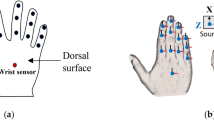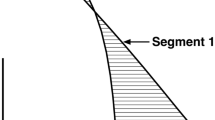Abstract
The identification of the kinaesthetic information used for directing 3D multi-joint arm movements toward a target remains an open question. Several psychophysical studies have suggested that the ability to perceive and control the spatial orientation of our limbs depends on the exploitation of the eigenvectors (e 3) of the inertia tensor (I ij ), which correspond to the arm rotational inertial axes. The present experiment aimed at investigating whether e 3 was used as a collective variable to direct the masses toward the target and hence to control the spatial accuracy of the final hand position. Natural, unconstrained, three-dimensional multi-joint reaching movements were submitted to alterations of forearm mass distribution. Given the existence of several “sensorimotor strategies” for the control of arm movements, the participants were a priori contrasted and ranged in groups according to their reliance on either visual or kinaesthetic information. The results indicated (1) the dependency of the arm’s directional control on I ij parameters, (2) a non-linear relationship between the performance predicted by the inertia tensor and the observed performance, depending on the deviation amplitude and (3) the presence of a large inter-individual variability suggesting the existence of different strategies, including proprioceptive compensation mechanisms. This study validates in unconstrained multi-joint arm movements the exploitation of the inertia tensor by the central nervous system, thus simplifying the coordination of the segments’ masses during reaching. The results also provide evidence for the existence of motor alternatives in exploiting proprioceptive information that may depend on spatial referencing modes.




Similar content being viewed by others
References
Adamovich SV, Berkinblit MB, Fookson O, Poizner H (1998) Pointing in 3D space to remembered targets. I. Kinesthetic vs visual target presentation. J Neurophysiol 79:2833–2846
Asch SE, Witkin HA (1992) Studies in space orientation. II. Perception of the upright with displaced visual fields and with body tilted (discussion 404–406). J Exp Psychol Gen 121:407–418
Bringoux L, Marin L, Nougier V, Barraud PA, Raphel C (2000) Effects of gymnastics expertise on the perception of body orientation in the pitch dimension. J Vestib Res 10(6):251–258
Craig CM, Bourdin C (2002) Revisited: the inertia tensor as a proprioceptive invariant in humans. Neurosci Lett 317:106–110
Darling WG, Gilchrist L (1991) Is there a preferred coordinate system for perception of hand orientation in three-dimensional space? Exp Brain Res 85:405–416
Desmurget M, Jordan M, Prablanc C, Jeannerod M (1997) Constrained and unconstrained movements involve different control strategies. J Neurophysiol 77:1644–1650
Desmurget M, Pelisson D, Rossetti Y, Prablanc C (1998) From eye to hand: planning goal-directed movements. Neurosci Biobehav Rev 22:761–788
Feldman AG, Latash ML (1982a) Afferent and efferent components of joint position sense; interpretation of kinaesthetic illusion. Biol Cybern 42:205–214
Feldman AG, Latash ML (1982b) Inversions of vibration-induced senso-motor events caused by supraspinal influences in man. Neurosci Lett 31:147–151
Flanagan JR, Lolley S (2001) The inertial anisotropy of the arm is accurately predicted during movement planning. J Neurosci 21:1361–1369
Flash T, Hogan N (1985) The coordination of arm movements: an experimentally confirmed mathematical model. J Neurosci 5:1688–1703
Garrett SR, Pagano C, Austin G, Turvey MT (1998) Spatial and physical frames of reference in positioning a limb. Percept Psychophys 60:1206–1215
Ghez C, Gordon J, Ghilardi MF, Sainburg R (1994) Contributions of vision and proprioception to accuracy in limb movements. MIT, Cambridge, pp 549–564
Ghez C, Gordon J, Ghilardi MF (1995) Impairments of reaching movements in patients without proprioception. II. Effects of visual information on accuracy. J Neurophysiol 73:361–372
Gordon J, Ghilardi MF, Cooper SE, Ghez C (1994) Accuracy of planar reaching movements. II. Systematic extent errors resulting from inertial anisotropy. Exp Brain Res 99:112–130
Gribble PL, Mullin LI, Cothros N, Mattar A (2003) Role of cocontraction in arm movement accuracy. J Neurophysiol 89:2396–2405
Hanavan EP (1964) A mathematical model of the humain body. AMRL TR 18:1–149
Hogan N (1984) An organizing principle for a class of voluntary movements. J Neurosci 4:2745–2754
Isableu B, Ohlmann T, Cremieux J, Amblard B (1998) How dynamic visual field dependence-independence interacts with the visual contribution to postural control. Hum Mov Sci 17:367–391
Isableu B, Ohlmann T, Cremieux J, Amblard B (2003) Differential approach to strategies of segmental stabilisation in postural control. Exp Brain Res 150:208–221
Kalaska JF, Crammond DJ (1992) Cerebral cortical mechanisms of reaching movements. Science 255:1517–1523
Kwon Y-H (2002) Flexibility of the experimental simulation approach to the analysis of human airborne movements: Body segment parameter estimation. In: Hong Y (eds) International research in sport biomechanics. Routledge, NewYork, pp 44–55
McLeod B (1985) Field dependence as factor in sports with preponderance of open or closed skills. Percept Motor Skills 60:369–370
Oltman PK (1968) A portable rod-and-frame apparatus. Percept Mot Skills 26:503–506
Pagano CC (2000) The role of the inertia tensor in kinesthesis. Crit Rev Biomed Eng 28:231–236
Pagano CC, Turvey MT (1995) The inertia tensor as a basis for the perception of limb orientation. J Exp Psychol Hum Percept Perform 21:1070–1087
Pagano CC, Garrett SR, Turvey MT (1996) Is limb proprioception a function of the limbs’ inertial eigenvectors? Ecol Psychol 43–69
Riley MA, Turvey MT (2001) Inertial constraints on limb proprioception are independent of visual calibration. J Exp Psychol Hum Percept Perform 27:438–455
Riley MA, Pagano CC (2003) Inertial Eigenvectors play a role in proprioception: comment on Craig and Bourdin (2002). Ecol Psychol 15:229–240
Rossetti Y, Meckler C, Prablanc C (1994) Is there an optimal arm posture? Deterioration of finger localization precision and comfort sensation in extreme arm-joint postures. Exp Brain Res 99:131–136
Rothwell JC, Traub MM, Day BL, Obeso JA, Thomas PK, Marsden CD (1982) Manual motor performance in a deafferented man. Brain 105(Pt 3):515–542 (see also pp3–42)
Sabes PN, Jordan MI (1997) Obstacle avoidance and a perturbation sensitivity model for motor planning. J Neurosci 17:7119–7128
Sabes PN, Jordan MI, Wolpert DM (1998) The role of inertial sensitivity in motor planning. J Neurosci 18:5948–5957
Sainburg RL, Poizner H, Ghez C (1993) Loss of proprioception produces deficits in interjoint coordination. J Neurophysiol 70:2136–2147
Sainburg RL, Ghilardi MF, Poizner H, Ghez C (1995) Control of limb dynamics in normal subjects and patients without proprioception. J Neurophysiol 73:820–835
Sainburg RL, Ghez C, Kalakanis D (1999) Intersegmental dynamics are controlled by sequential anticipatory, error correction, and postural mechanisms. J Neurophysiol 81:1045–1056
Sanes JN, Shadmehr R (1995) Sense of muscular effort and somesthetic afferent information in humans. Can J Physiol Pharmacol 73:223–233
Soechting JF, Flanders M (1992) Moving in three-dimensional space: frames of reference, vectors, and coordinate systems. Annu Rev Neurosci 15:167–191
van Beers RJ, Sittig AC, Denier van der Gon JJ (1998) The precision of proprioceptive position sense. Exp Brain Res 122:367–377
Viviani P, Flash T (1995) Minimum-jerk, two-thirds power law, and isochrony: converging approaches to movement planning. J Exp Psychol Hum Percept Perform 21:32–53
Vuillerme N, Danion F, Marin L, Boyadjian A, Prieur JM, Weise I, Nougier V (2001a) The effect of expertise in gymnastics on postural control. Neurosci Lett 303:83–86
Vuillerme N, Teasdale N, Nougier V (2001b) The effect of expertise in gymnastics on proprioceptive sensory integration in human subjects. Neurosci Lett 311:73–76
Acknowledgements
This research was supported by the French Fond National pour la Science (IUF 2002:2006), and by Enactive Interfaces, a network of excellence (IST contract #002114) of the Commission of the European Community, with additional support from the University of Paris Sud 11 (BQR-RV-2003).
Author information
Authors and Affiliations
Corresponding author
Rights and permissions
About this article
Cite this article
Bernardin, D., Isableu, B., Fourcade, P. et al. Differential exploitation of the inertia tensor in multi-joint arm reaching. Exp Brain Res 167, 487–495 (2005). https://doi.org/10.1007/s00221-005-0161-4
Received:
Accepted:
Published:
Issue Date:
DOI: https://doi.org/10.1007/s00221-005-0161-4




